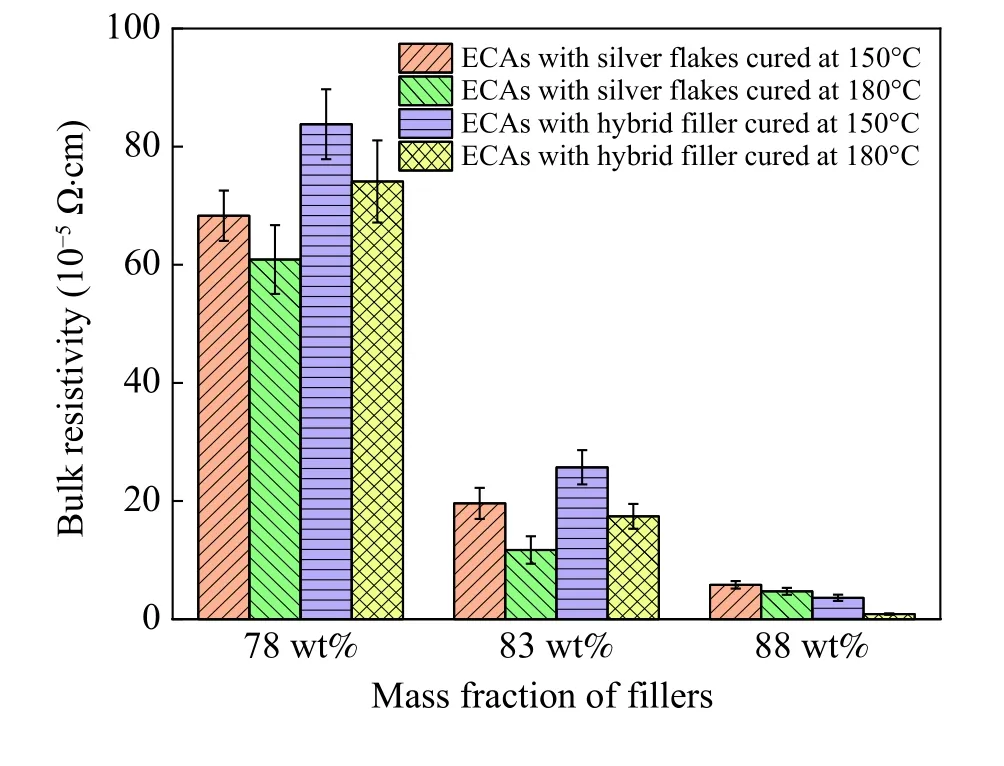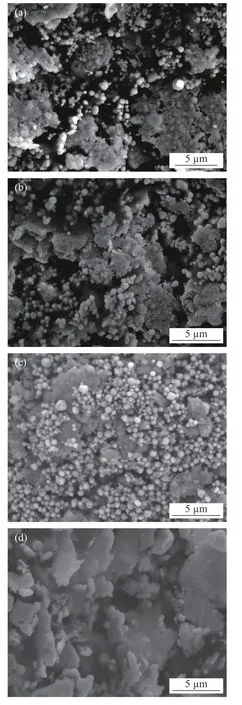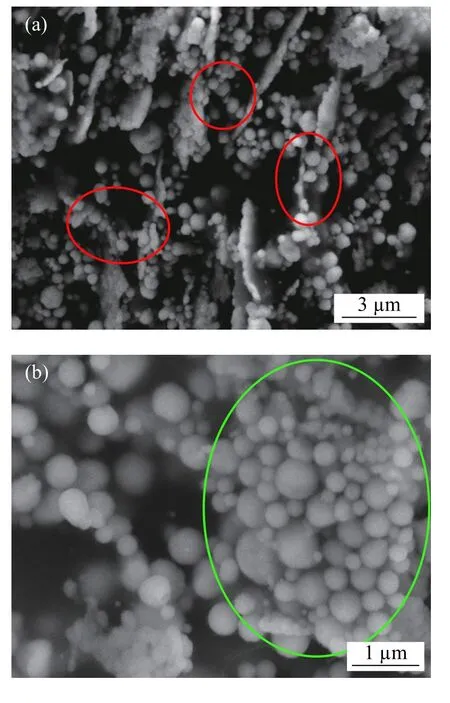Application of silver nanoparticles in electrically conductive adhesives with silver micro flakes
2022-07-26LiuHaoMaRuiZhaoDingweiCuiZhiyuanZhangWeiweiWangJianqiang
Liu Hao , Ma Rui , Zhao Dingwei , Cui Zhiyuan , Zhang Weiwei , Wang Jianqiang
1. Harbin Institute of Technology (Shenzhen), Shenzhen 518054, China;2. Academy of Defense Technology, China Aerospace Science and Industry Corp., Beijing 100854, China
Abstract This study has been conducted to evaluate the application of silver nanoparticles (NPs) in Electrically Conductive Adhesives(ECAs), filled with hybrid silver flakes and NPs, and silver flakes as a control sample, at a filler loading of 78 wt.%, 83 wt.% and 88 wt.%and cured at 150 ℃ and 180 ℃, respectively. The results show that the electrical and thermal conductivities of ECAs were improved with the increasing of filler loading and curing temperature. Adding silver NPs in silver flakes negatively affected the electrical and thermal conductivities of ECAs at a low filler mass fraction of 78 wt.%, because the segregation of NPs enlarged the average distance of silver flakes; while it positively influenced the electrical and thermal conductivities of ECAs at a loading ratio of 88 wt.%, probably due to NPs filling in the gaps between silver flakes or even sintering together with each other or with silver flakes, especially when curing at high temperature of 180 ℃.
Key words electrically conductive adhesives, silver nanoparticles, mass fraction, curing temperature
0 Introduction
Since developed in the 1950s, Electrically conductive adhesives (ECAs) have played an important role in electronic packaging, and turned to be one of the most widely used interconnecting materials, due to its advantages of simple operation, low process temperature, good wettability on most material surfaces, strong fine wire ability and lead-free characteristics[1 – 2]. However, in the current development trend of high packaging density of electronic products,ECAs are facing great challenges due to its poor low electrical and thermal conductivities[3 – 4]. Therefore, extensive researches were carried out to improve the properties of ECAs, for example, mixing the traditional micro silver flakes with or replacing by other fillers such as low melting point metals[5], silver nano particles[6], silver nanowires[7 – 8],graphite[9], nanotube[10]and other metals particles[11 – 13].
Among these new fillers, silver nanoparticles were considered as one of the promising materials to meet the need of high energy density in the future, due to the high electrical and thermal conductivities of silver, perfect compatibility with traditional silver flake fillers and low melting temperature to sinter with silver flakes to further improve its electrical and thermal conductivity[14,15]. Silver particles in their nano-forms such as silver nanowires, nanoparticles, and nanorods provide superior electrical conductivities and other properties in comparison with their micro-forms. Previous examinations of the silver-filled particles revealed that the micro-sized particle fillers appeared as full density silver flakes, while nanoparticle fillers appeared as highly porous agglomerates, similar to open-cell foams. Generally, it improved electrical conductivity of ECAs by adding silver nanoparticles with a particular fill ratio[16]. Cheng et al[17]prepared a UV-curable epoxy adhesive with silver nanoparticles in the absence of capping agent and found that the surface electrical resistivity of the adhesive may be reduced to 4.40×102Ω/m after exposure to an energy density of 900 mJ/cm2. Zulkarnain et al.[18]evaluated the effects of different volume fractions of silver particles of different size(microsize, 2 μm to 3.5 μm diameter; nanosize, 80 nm diameter) on the thermal and electrical characteristics of epoxy–Ag ECAs, as well as hybrid ECAs with both particle sizes at different ratios. Improved thermal and electrical conductivities resulted from the interaction between the particles, as evaluated by analysis of sample morphology. In the hybrid system, the thermal conductivity of ECAs decreased with increasing micro Ag particle filler ratio. The highest electrical conductivity of the hybrid composite was obtained at 50:50 weight ratio of micro and nano particles.
However, it was also reported that the nano Ag-filled ECAs showed higher bulk resistivity than that filled with micron silver flakes. Ye et al.[19]introduced nanoparticles in micro sized metal particles to study particle distribution in polymer matrix. It is revealed that the perfect continuous linkage of particles is hard to find and the chance of different contact and contact area becomes less with increasing amount of nano particles. Based on the measurement of resistivity, it is deduced that the conductivity of micro-sized Ag-particle filled adhesives is dominated by constriction resistance, while the nano particle containing adhesives is controlled by tunnelling and even thermionic emission. Lee et al.[20]studied the film resistivity of ECAs made by adding micro-sized silver flakes, mixed-sized silver particles or nano-sized silver colloids to the polyvinyl acetate (PVAc)emulsion, as a function of silver volume fraction. Results indicated that the addition of nano-sized silver colloids to micro-sized Ag flakes usually increased its resistivity. Only near the percolation threshold, would the addition of nanosized silver particles decrease the resistivity by helping to form the conductive path. Films made with only nano-sized silver colloids at the volume fraction of 0.848 showed a rather low resistivity of 1.93×10−4Ω·cm. Increase in heating temperature helped to form necks between particles and thus improve the conductivity to some extent.
Previous work had also studied the curing behavior of ECAs and their influence on performance properties. Xiong et al.[21]examined the effect of curing procedures on the electrical properties of ECAs reinforced with silver flakes. It revealed that both curing temperature and time had effects on volume resistivity which decreased from 5.2 × 10−4Ω·m to 4.5 × 10−5Ω·m when cured at 250 ºC. Gao et al.[22]studied the effect of curing and post-heating procedures on the bulk resistivity of ECAs, and found that the bulk resistivity of the ECAs cured by a multi-step process were lower than that cured by a one-step method, even though they were cured for the same time.
In this study, ECAs were prepared with the same resin matrix and technics but different fillers, which are silver flakes and hybrid silver flakes and NPs, respectively, to analyze the influence of silver NPs on the performance of ECAs.
1 Experiments
1.1 Main materials and reagents
Silver micro flakes (density 4.8 g/cm3) were purchased from Guiyan Platinum Industry Co., Ltd. Silver nanoparticles (NPs) were purchased from Changsha Tianjiu Co.,Ltd. The Bisphenol A NPEL-128 epoxy resin was purchased from South Asia Plastic Industry Co., Ltd., and other materials such as curing agent Methyl Hexahydrophthalic Anhydride (MeHHPA) and 2-Ethyl-4-Methylimidazole(2E4MZ), silane coupling agent (KH560) and adipic acid were all purchased from Aladdin.
NPEL-128 epoxy resin, MeHHPA, 2E4MZ, KH560,and adipic acid shall be mixed evenly at a mass ratio of 125:100:1:1.25:7.5 to obtain the resin matrix of ECAs, and the mixture was sonicated in an ultrasonic bath for at least 10 min.
1.2 Preparation of ECAs
Typical epoxy–silver composites were characterized by preparing a hybrid silver filler with silver flakes and silver NPs at a mass ratio of 85:15 (hereinafter referred to as hybrid filler), and only silver flakes as a control sample. Each set was prepared at the silver mass fractions of 78 wt.%,83 wt.% and 88wt.%, respectively. All composites of epoxy matrix and silver filler were fully ground for 30 min to be completely wetted and dispersed evenly, then stirred for approximately 10 min for homogenization. Afterwards, the mixture was sonicated for approximately 30 min in a sonification bath to disperse the fillers in the paste. Then the fully ground ECAs was put into the RM300SA2 Planetary Gravity Mixer, and the rotating speed was gradually increased to 2000 r/min and kept for about 3 min.
1.3 Testing and characterization
HITACHI SU5000 Field Emission Scanning Electron Microscopy (FESEM) was adopted to analyze the morphology of raw materials and fracture surface of ECAs. Bulk resistivities of ECAs were measured at room temperature with the RTS-11 Metal Four Probe Tester from Guangzhou Four Probe Technology Company, in which the thin film specimens were made on a glass slide with dimensions of 60 mm × 3 mm × 0.1 mm. The thermal conductivity of the ECAs was calculated from the product of density, specific heat capacity, and thermal diffusion coefficient of the sample, which were measured at room temperature on Mettler Toledo Densitometer, NETSCH DSC214 Differential Scanning Calorimeter and LFA467 Laser Thermal Conductivity Meter, respectively.
As a comparative study, two groups of ECAs specimens were put into ESPEC STH-120 High Temperature Test Chamber, and the temperature was gradually increased from room temperature to 150 ℃ and 180 ℃ respectively,and kept for 2 hours for completely curing before testing.
2 Experimental results and discussion
2.1 Characteristics of fillers and ECAs
The average particle sizes of the silver micro flakes and NPs were 7.13 μm and 300 nm, respectively. FESEM images clearly show the typical morphology of silver flakes and NPs as in Fig. 1 a and Fig. 1 b. To study the morphology change of silver fillers when ECAs curing, the silver flakes and NPs were also observed on FESEM after storing in the same high temperature chamber with ECAs specimens when curing at 180 ℃, as shown in Fig. 1 c and Fig. 1 d.
It could be found in Fig. 1 b and Fig. 1 d that there was no obvious change of silver flakes in the same chamber with ECAs curing at 180 ℃, but in Fig. 1 a and Fig. 1 c a sintering occurred between silver NPs to form a silver network.The phenomenon of NPs sintering is always expected to occur in ECAs to shorten the distance between silver flakes or even connect adjacent silver flakes together. The bulk resistivity and thermal conductivity of the ECAs are characterized by different silver filler morphologies, mass fractions,and curing temperature, as shown in Fig. 2 and Fig. 3.

Fig.1 SEM images of (a) silver flakes,(b) silver NPs,(c) silver flakes with ECAs curing,(d) silver NPs with ECAs curing
2.2 Influence of filler loading ratio
It could be concluded from Fig. 2 and Fig. 3 that the bulk resistivity of ECAs decreases and the thermal conductivity increases with the increasing of the silver filler loading ratio. Regarding this phenomenon, the ECAs filled with both silver flakes and hybrid filler shows similar bulk resistivity and thermal conductivity trends. As shown in Fig. 4 a−Fig. 4 c, there are less gaps between silver fillers in ECAs when the mass fraction of the filler increases. It could also be found that the bulk resistivity of ECAs with hybrid filler is higher than that with silver flakes when loading at the same ratio of 78 wt.% and 83 wt.%. This phenomenon confirms that the using of silver NPs would reduce the electrical and thermal conductivities of ECAs, probably due to the higher surface energy attraction and segregation of silver NPs[20]to enlarge the average distance of micro silver flakes, as reported by other studies[18,23]. However, the bulk resistivity of ECAs with hybrid filler is lower than that with silver flakes at 88 wt.% filler loading, and the thermal conductivity of ECAs with hybrid filler is higher than that with silver flakes at 88 wt.% filler loading. Silver NPs could be easily distinguished in Fig. 4 c from the micrographs on the fracture surface of ECAs with hybrid filler, revealing that the continuous dispersal of the silver NPs clustered in the gaps between silver micro particles. It is hardly to conclude whether the silver NPs increase the gaps between micro flakes or not in the ECAs at a filler loading ratio of 88 wt.%, because the whole fracture surface is crowded with hybrid silver flakes and NPs to form a network of silver and there are little gaps in the whole fracture surface. In this case, the bulk resistivity of ECAs could be reduced and the thermal conductivity could be improved.

Fig.2 Bulk resistivity of ECAs specimens with different fillers after curing at 150 ℃ and 180 ℃

Fig.3 Thermal conductivity of ECAs specimens with different fillers after curing at 150 ℃ and 180 ℃

Fig.4 SEM images of fracture surface of ECAs filled by(a) hybrid filler at 78 wt.% (b) hybrid filler at 83 wt.%(c) hybrid filler at 88 wt.% (d) silver flakes at 88 wt.%
2.3 Influence of curing temperature
Two groups of ECAs specimens were cured at 150 ℃and 180 ℃, respectively. It could be seen from Fig. 2 and Fig. 3 that a higher curing temperature of 180 ℃ is conducive to reduce the bulk resistivity and increase the thermal conductivity of ECAs filled by both of the silver flakes and hybrid filler. Meanwhile, the bulk resistivity of ECAs with the hybrid filler at a loading of 88 wt.% is greatly lower than that with silver flakes, a similar phenomenon also occurs on the thermal conductivity of ECAs, which presents an inverse relationship with that of ECAs at the filler loading of 78 wt.% and 83 wt.%.
To investigate this phenomenon, the fracture surfaces of ECAs with different filler loading ratios were observed and compared under FESEM after curing at 180 ℃, as shown in Fig. 5. When the filler mass fraction is 78 wt.% as shown in Fig. 5 a, NPs distributed between silver flakes because of their tendency to agglomerate and enlarges the average gaps of silver micro flakes. Even though electrical conductive channels could be established along the NPs as shown in the red circle of Fig. 5a, the particles are still isolated and the particle contact resistance is increased significantly, resulting in higher bulk resistance and lower thermal conductivity than ECAs with silver flakes. When the filler mass fraction is increased to 88 wt.%, NPs enrich the gaps in the ECAs, in spite of the negative effect on the silver NPs distribution due to their tendency to agglomerate in ECAs[24].When curing at 180 ℃, sintering of NPs occurs and links with silver flakes when they are close enough to each other,or even forms new micro flakes and electrical conductive network as shown in the green circle in Fig. 5 b, resulting in the decrease of bulk resistance and improvement of thermal conductivity. It is noteworthy that the thermal conductivity of ECAs with 88 wt.% hybrid filler reached to 24 W/mK,and it is possible to be further reduced when using in the high temperature working circumstance of power device packaging.

Fig.5 SEM images of surface fracture of ECAs after curing at 180 ℃ at the filler loading of (a) 78 wt.% (b) 88 wt.%
3 Conclusions
(1) The adding of silver NPs in micro silver flaky fillers negatively affects the electrical and thermal conductivity of ECAs at a filler loading ratio of 78 wt.%, due to the increase of gap between silver flakes and particle contact resistance.
(2) Higher curing temperature, for example, 180 ℃rather than 150 ℃, could promote the sintering of NPs in ECAs indeed, to significantly reduce the bulk resistance and improve the thermal conductivity of ECAs at high filler mass fraction of 88 wt.%.
(3) It is a possible solution of interconnection materials in future power device packaging by preparing ECAs with hybrid silver NPs and micro flakes at high mass fraction.
杂志排行
China Welding的其它文章
- The study of arc behavior with different content of copper vapor in GTAW
- Research on stretching flame correction technology of aluminum alloy ship frame skin welding structure
- Groove modeling and digital simulation for intersecting structures of circular tubes based on coplanarity of vectors
- A novel single wire indirect arc metal inert gas welding process operated in streaming mode
- A review of welding residual stress test methods
- Ceramic-copper substrate technology introduction
